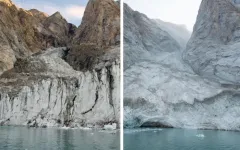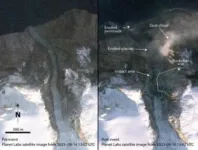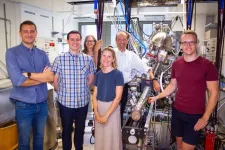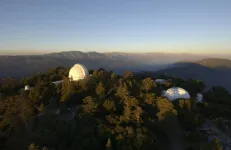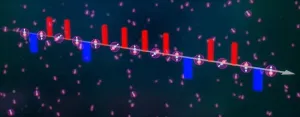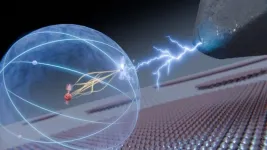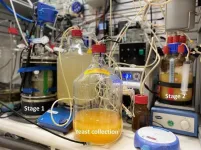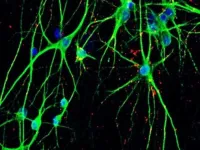(Press-News.org) A landslide in a remote part of Greenland caused a mega-tsunami that sloshed back and forth across a fjord for nine days, generating vibrations throughout Earth, according to a new study involving UCL researchers.
The study, published in the journal Science, concluded that this movement of water was the cause of a mysterious, global seismic signal that lasted for nine days and puzzled seismologists in September 2023.
The initial event, not observed by human eye, was the collapse of a 1.2km-high mountain peak into the remote Dickson Fjord beneath, causing a backsplash of water 200 metres in the air, with a wave up to 110 metres high. This wave, extending across 10km of fjord, reduced to seven metres within a few minutes, the researchers calculated, and would have fallen to a few centimetres in the days after.
The team used a detailed mathematical model, recreating the angle of the landslide and the uniquely narrow and bendy fjord, to demonstrate how the sloshing of water would have continued for nine days, with little energy able to escape.
The model predicted that the mass of water would have moved back and forth every 90 seconds, matching the recordings of vibrations travelling in the Earth’s crust all around the globe.
The landslide, the researchers wrote, was a result of the glacier at the foot of the mountain thinning, becoming unable to hold up the rock-face above it. This was ultimately due to climate change. The landslide and tsunami were the first observed in eastern Greenland.
Co-author Dr Stephen Hicks, of UCL Earth Sciences, said: “When I first saw the seismic signal, I was completely baffled. Even though we know seismometers can record a variety of sources happening on Earth’s surface, never before has such a long-lasting, globally travelling seismic wave, containing only a single frequency of oscillation, been recorded. This inspired me to co-lead a large team of scientists to figure out the puzzle.
“Our study of this event amazingly highlights the intricate interconnections between climate change in the atmosphere, destabilisation of glacier ice in the cryosphere, movements of water bodies in the hydrosphere, and Earth’s solid crust in the lithosphere.
“This is the first time that water sloshing has been recorded as vibrations through the Earth’s crust, travelling the world over and lasting several days.”
The mysterious seismic signal – coming from a vibration through the Earth’s crust – was detected by seismometers all over the globe, from the Arctic to Antarctica. It looked completely different to frequency-rich ‘rumbles’ and ‘pings’ from earthquake recordings, as it contained only a single vibration frequency, like a monotonous-sounding hum.
When the study’s authors first discovered the signal, they made a note of it as a “USO”: unidentified seismic object.
At the same time, news of a large tsunami in a remote northeast Greenland fjord reached authorities and researchers working in the area.
The researchers joined forces in a unique multidisciplinary group involving 68 scientists from 40 institutions in 15 countries, combining seismometer and infrasound data, field measurements, on-the-ground and satellite imagery, and simulations of tsunami waves.
The team also used imagery captured by the Danish military who sailed into the fjord just days after the event to inspect the collapsed mountain-face and glacier front along with the dramatic scars left by the tsunami.
It was this combination of local field data and remote, global-scale observations that allowed the team to solve the puzzle and reconstruct the extraordinary cascading sequence of events.
Lead author Dr Kristian Svennevig, from the Geological Survey of Denmark and Greenland (GEUS), said: “When we set out on this scientific adventure, everybody was puzzled and no one had the faintest idea what caused this signal. All we knew was that it was somehow associated with the landslide. We only managed to solve this enigma through a huge interdisciplinary and international effort.”
He added: “As a landslide scientist, an additional interesting aspect of this study is that this is the first-ever landslide and tsunami observed from eastern Greenland, showing how climate change already has major impacts there.”
The team estimated that 25 million cubic metres of rock and ice crashed into the fjord (enough to fill 10,000 Olympic-sized swimming pools).
They confirmed the size of the tsunami, one of the largest seen in recent history, using numerical simulations as well as local data and imagery.
Seventy kilometres away from the landslide, four-metre-high tsunami waves damaged a research base at Ella Ø (island) and destroyed cultural and archaeological heritage sites across the fjord system.
The fjord is on a route commonly used by tourist cruise ships visiting the Greenland fjords. Fortunately, no cruise ships were close to Dickson Fjord on the day of the landslide and tsunami, but if they had been, the consequences of a tsunami wave of that magnitude could have been devastating.
Mathematical models recreating the width and depth of the fjord at very high resolution demonstrated how the distinct rhythm of a mass of water moving back and forth matched the seismic signal.
The study concluded that with rapidly accelerating climate change, it will become more important than ever to characterise and monitor regions previously considered stable and provide early warning of these massive landslide and tsunami events.
Co-author Thomas Forbriger, from Karlsruhe Institute of Technology, said: “We wouldn’t have discovered or been able to analyse this amazing event without networks of high-fidelity broadband seismic stations around the world, which are the only sensors that can truly capture such a unique signal.”
Co-author Anne Mangeney, from Université Paris Cité, Institut de Physique du Globe de Paris, said: “This unique tsunami challenged the classical numerical models that we previously used to simulate just a few hours of tsunami propagation. We had to go to an unprecedentedly high numerical resolution to capture this long-duration event in Greenland. This opens up new avenues in the development of numerical methods for tsunami modelling.”
END
Climate-change-triggered landslide caused Earth to vibrate for nine days
A landslide in a remote part of Greenland caused a mega-tsunami that sloshed back and forth across a fjord for nine days, generating vibrations throughout Earth, according to a new study involving UCL (University College London) researchers
2024-09-12
ELSE PRESS RELEASES FROM THIS DATE:
Microbe dietary preferences influence the effectiveness of carbon sequestration in the deep ocean
2024-09-12
Woods Hole, Mass. (September 13, 2024) - The movement of carbon dioxide (CO2) from the surface of the ocean, where it is in active contact with the atmosphere, to the deep ocean, where it can be sequestered away for decades, centuries, or longer, depends on a number of seemingly small processes.
One of these key microscale processes is the dietary preferences of bacteria that feed on organic molecules called lipids, according to a journal article, "Microbial dietary preference and interactions affect the export of lipids to the deep ocean," published in Science.
"In ...
The insulator unraveled
2024-09-12
Aluminum oxide (Al2O3), also known as alumina, corundum, sapphire, or ruby, is one of the best insulators used in a wide range of applications: in electronic components, as a support material for catalysts, or as a chemically resistant ceramic, to name a few. Knowledge of the precise arrangement of the surface atoms is key to understanding how chemical reactions occur on this material, such as those in catalytic processes. Atoms inside the material follow a fixed arrangement, giving rise to the characteristic shapes ...
$3.5M grant to Georgia State will fuel space research across the globe
2024-09-12
ATLANTA — A new three-year, $3.5 million grant from the U.S. National Science Foundation will foster new research at Georgia State’s Center for High Angular Resolution Astronomy (CHARA) Array by astronomers from around the world.
The grant will fund open-access time at the CHARA Array through the NSF National Optical-Infrared Astronomy Research Laboratory (NSF NOIRLab). The program offers astronomers the opportunity to apply for observing time at the CHARA Array to investigate all kinds of objects ...
Polar molecules dance to the tunes of microwaves
2024-09-12
The interactions between quantum spins underlie some of the universe’s most interesting phenomena, such as superconductors and magnets. However, physicists have difficulty engineering controllable systems in the lab that replicate these interactions.
Now, in a recently published Nature paper, JILA and NIST Fellow and University of Colorado Boulder Physics Professor Jun Ye and his team, along with collaborators in Mikhail Lukin’s group at Harvard University, used periodic microwave pulses in a process known as Floquet engineering, to tune interactions between ultracold potassium-rubidium molecules in a system appropriate for studying fundamental magnetic ...
Quantum researchers cause controlled ‘wobble’ in the nucleus of a single atom
2024-09-12
Researchers from Delft University of Technology in The Netherlands have been able to initiate a controlled movement in the very heart of an atom. They caused the atomic nucleus to interact with one of the electrons in the outermost shells of the atom. This electron could be manipulated and read out through the needle of a scanning tunneling microscope. The research, published in Nature Communications today, offers prospects for storing quantum information inside the nucleus, where it is safe from external disturbances.
For weeks on end, the researchers studied a single titanium atom. “A Ti-47 atom, to be precise,” ...
Foods with low Nutri-Scores associated with an increased risk of cardiovascular diseases
2024-09-12
Cardiovascular diseases are the leading cause of mortality in Western Europe, accounting for 1/3 of deaths in 2019. Diet is thought to be responsible for around 30% of such deaths. Nutrition-related prevention policies therefore constitute a major public health challenge for these diseases.
In an article to be published on 11 September 2024 in Lancet Regional Health - Europe, researchers from the Nutritional Epidemiology Research Team (CRESS-EREN), with members from Inserm, Inrae, Cnam, Université Sorbonne Paris Nord and Université Paris ...
Research reveals reality of Ice Age teen puberty
2024-09-12
Landmark new research shows Ice Age teens from 25,000 years ago went through similar puberty stages as modern-day adolescents. In a study published today in the Journal of Human Evolution of the timing of puberty in Pleistocene teens, researchers are addressing a knowledge gap about how early humans grew up.
Found in the bones of 13 ancient humans between 10 and 20 years old is evidence of puberty stages. Co-led by University of Victoria (UVic) paleoanthropologist April Nowell, researchers found specific markers in the bones that allowed them to assess the progress of adolescence.
“By analyzing specific areas of the skeleton, we inferred things like menstruation ...
Use of biomarkers in the management of inflammatory bowel disease
2024-09-12
Inflammatory bowel disease (IBD), encompassing Crohn’s disease (CD) and ulcerative colitis (UC), is a chronic inflammatory disorder of the gastrointestinal (GI) tract that significantly impacts the quality of life of patients. With an incidence of approximately one in 200 individuals in developed countries and a rising trend in developing and newly industrialized nations, IBD poses a substantial burden on healthcare systems. Due to the nonspecific nature of its clinical manifestations and the lack of a gold-standard diagnostic test, managing IBD effectively remains a challenge. Therefore, reliable and widely available biomarkers ...
Powered by renewable energy, microbes turn CO2 into protein and vitamins
2024-09-12
Researchers in Germany can harvest protein and vitamin B9 from microbes by feeding them nothing much more than hydrogen, oxygen, and CO2. The technology, published September 12 in the Cell Press journal Trends in Biotechnology, runs on renewable energy to produce a sustainable, micronutrient-enriched protein alternative that may one day make it to our plates.
“This is a fermentation process similar to how you make beer, but instead of giving the microbes sugar, we gave them gas and acetate,” says corresponding author Largus Angenent of the University of Tübingen, Germany. “We knew that yeast could produce vitamin B9 on their own with sugar, however, we didn’t ...
Scientists aim to decode the genetic roots of mental illness on a large scale
2024-09-12
Neurodevelopmental and psychiatric disorders (NPD) including schizophrenia, bipolar disorder, autism, and depression are detrimental to individuals, their families and society as a whole, and in many cases still lack effective treatments. It’s becoming more and more clear that genetic mutations in certain genes can increase the likelihood of developing NPD, and several hundreds of those “risk genes” have been identified to date, but their role related to NPD remains a mystery. “Very little is known about the basic function of most of these genes, and what we do know ...
LAST 30 PRESS RELEASES:
Shingles vaccine linked to slower biological aging in older adults
A self-assembling shortcut to better organic solar cells
A two-week leap in breeding: Antarctic penguins’ striking climate adaptation
Climate risks to insurance and reinsurance of global supply chains
58% of patients affected by 2022 mpox outbreak report lasting physical symptoms
Golden Gate method enables rapid, fully-synthetic engineering of therapeutically relevant bacteriophages
Polar weather on Jupiter and Saturn hints at the planets’ interior details
Socio-environmental movements: key global guardians of biodiversity amid rising violence
Global warming and CO2 emissions 56 million years ago resulted in massive forest fires and soil erosion
Hidden order in quantum chaos: the pseudogap
Exploring why adapting to the environment is more difficult as people age
Society for Laboratory Automation and Screening welcomes new scientific director: Madeline M. Farley, Ph.D.
Austrian cow shows first case of flexible, multi-purpose tool use in cattle
Human nasal passages defend against the common cold and help determine how sick we get
Research alert: Spreading drug costs over the year may ease financial burden for Medicare cancer patients
Hospital partnership improves follow up scans, decreases long term risk after aortic repair
Layered hydrogen silicane for safe, lightweight, and energy-efficient hydrogen carrier
Observing positronium beam as a quantum matter wave for the first time
IEEE study investigates the effects of pointing error on quantum key distribution systems
Analyzing submerged fault structures to predict future earthquakes in Türkiye
Quantum ‘alchemy’ made feasible with excitons
‘Revoice’ device gives stroke patients their voice back
USF-led study: AI helps reveal global surge in floating algae
New method predicts asthma attacks up to five years in advance
Researchers publish first ever structural engineering manual for bamboo
National poll: Less than half of parents say swearing is never OK for kids
Decades of suffering: Long-term mental health outcomes of Kurdish chemical gas attacks
Interactional dynamics of self-assessment and advice in peer reflection on microteaching
When aging affects the young: Revealing the weight of caregiving on teenagers
Can Canada’s health systems handle increased demand during FIFA World Cup?
[Press-News.org] Climate-change-triggered landslide caused Earth to vibrate for nine daysA landslide in a remote part of Greenland caused a mega-tsunami that sloshed back and forth across a fjord for nine days, generating vibrations throughout Earth, according to a new study involving UCL (University College London) researchers
